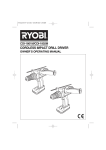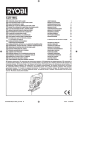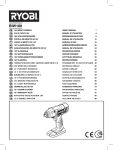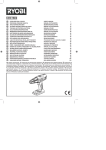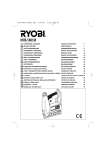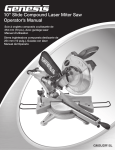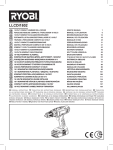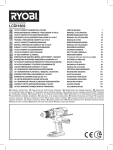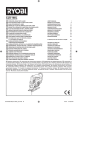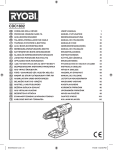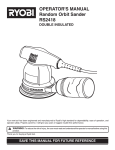Download Ryobi CDI-1801M Specifications
Transcript
960223559-02(CDI-1801M/CDI-1802M) CDI-1801M/CDI-1802M CORDLESS IMPACT DRILL DRIVER 15 15 OWNER’S OPERATING MANUAL Important! It is essential that you read the instructions in this manual before mounting and operating this machine. Subject to technical modifications English b) Use safety equipment. Always wear eye protection. Safety equipment such as dust mask, non-skid safety shoes, hard hat, or hearing protection used for appropriate conditions will reduce personal injuries. c) Avoid accidental starting. Ensure the switch is in the off position before plugging in. Carrying power tools with your finger on the switch or plugging in power tools that have the switch on invites accidents. d) Remove any adjusting key or wrench before turning the power tool on. A wrench or a key left attached to a rotating part of the power tool may result in personal injury. e) Do not overreach. Keep proper footing and balance at all times. This enables better control of the power tool in unexpected situations. f) Dress properly. Do not wear loose clothing or jewellery. Keep your hair, clothing and gloves away from moving parts. Loose clothes, jewellery or long hair can be caught in moving parts. g) If devices are provided for the connection of dust extraction and collection facilities, ensure these are connected and properly used. Use of these devices can reduce dust related hazards. GENERAL SAFETY RULES WARNING Read all instructions. Failure to follow all instructions listed below may result in electric shock, fire and/or serious injury. The term "power tool'' in all of the warnings listed below refers to your mains operated (corded) power tool or battery operated (cordless) power tool. SAVE THESE INSTRUCTIONS. 1) WORK AREA a) Keep work area clean and well lit. Cluttered and dark areas invite accidents. b) Do not operate power tools in explosive atmospheres, such as in the presence of flammable liquids, gases, or dust. Power tools create sparks which may ignite the dust or fumes. c) Keep children and bystanders away while operating a power tool. Distractions can cause you to lose control. 2) ELECTRICAL SAFETY a) Power tool plugs must match the outlet. Never modify the plug in any way. Do not use any adapter plugs with earthed(grounded) power tools. Unmodified plugs and matching outlets will reduce risk of electric shock. b) Avoid body contact with earthed or grounded surfaces such as pipes, radiators, ranges and refrigerators. There is an increased risk of electric shock if your body is earthed or grounded. c) Do not expose power tools to rain or wet conditions. Water entering a power tool will increase the risk of electric shock. d) Do not abuse the cord. Never use the cord for carrying, pulling or unplugging the power tool. Keep cord away from heat, oil, sharp edges or moving parts. Damaged or entangled cords increase the risk of electric shock. e) When operating a power tool outdoors, use an extension cord suitable for outdoor use. Use of a cord suitable for outdoor use reduces the risk of electric shock. 4) POWER TOOL USE AND CARE a) Do not force the power tool. Use the correct power tool for your application. The correct power tool will do the job better and safer at the rate for which it was designed. b) Do not use the power tool if the switch does not turn it on and off. Any power tool that can not be controlled with the switch is dangerous and must be repaired. c) Disconnect the plug from the power source before making any adjustments, changing accessories, or storing power tools. Such preventive safety measures reduce the risk of starting the power tool accidentally. d) Store idle power tools out of the reach of children and do not allow persons unfamiliar with the power tool or these instructions to operate the power tool. Power tools are dangerous in the hands of untrained users. e) Maintain power tools. Check for misalignment or bindling of moving parts, breakage of parts and any other condition that may affect the power tools operation. If damaged, have the power tool repaired before use. Many accidents are caused by poorly maintained power tools. f) Keep cutting tools sharp and clean. Properly maintained cutting tools with sharp cutting edges are less likely to bind and are easier to control. 3) PERSONAL SAFETY a) Stay alert, watch what you are doing and use common sense when operating a power tool. Do not use a power tool while you are tired or under the influence of drugs, alcohol or medication. A moment of inattention while operating power tools may result in serious personal injury. 1 English GENERAL SAFETY RULES No load speed (impact mode): -Lo speed (min-1) 0 - 5200 -Hi speed (min-1) 0 - 18200 35 Max.Torque (Nm) Battery pack (Not included): BPP-1817M/ BPP-1815M Charger (Not included) BC-1800/ BC-1815S g) Use the power tool, accessories and tool bits etc., in accordance with these instructions and in the manner intended for the particular type of power tool, taking into account the working conditions and the work to be performed. Use of the power tool for operations different from intended could result in a hazardous situation. 0 - 5200 0 - 18200 35 BPP-1817M/ BPP-1815M BC-1800/ BC-1815S DESCRIPTION 5) BATTERY TOOL USE AND CARE a) Ensure the switch is in the off position before inserting battery pack. Inserting the battery pack into power tools that have the switch on invites accidents. b) Recharge only with the charger specified by the manufacturer. A charger that is suitable for one type of battery pack may create a risk of fire when used with another battery pack. c) Use power tools only with specifically designated battery packs. Use of any other battery packs may create a risk of injury and fire. d) When battery pack is not in use, keep it away from other metal objects like paper clips, coins, keys, nails, screws, or other small metal objects that can make a connection from one terminal to another. Shorting the battery terminals together may cause burns or a fire. e) Under abusive conditions, liquid may be ejected from the battery; avoid contact. If contact accidentally occurs, flush with water. If liquid contacts eyes, additionally seek medical help. Liquid ejected from the battery may cause irritation or burns. 1. 2. 3. 4. 5. 6. 7. 8. 9. 10. 11. 12. 13. Keyless chuck Switch trigger Direction of rotation selector (Forward/Reverse) Screwdriver bits Magnetic tray Battery pack (NOT INCLUDED) Latches Auxiliary Handle Depth Gauge Rod Torque adjusting Ring Drill mode Impact mode Reverse 14. 15. Forward Chuck jaws OPERATION TO INSTALL BATTERY PACK (NOT INCLUDED) (Fig.2) Lock switch trigger on your drill by placing the direction of rotation selector in center position. Place battery pack in your drill. Align raised rib on battery pack with groove inside drill. Make sure the latches on battery pack snap in place and battery pack is secured in drill before beginning operation. 6) SERVICE a) Have your power tool serviced by a qualified repair person using only identical replacement parts. This will ensure that the safety of the power tool is maintained. 7) SPECIAL RULES TO REMOVE BATTERY PACK(NOT INCLUDED) (Fig.2) a) Wear ear protectors with impact drills. Exposure to noise can cause hearing loss. b) Use auxiliary handles supplied with the tool. Loss of control can cause personal injury. Lock switch trigger on your drill by placing the direction of rotation selector in center position. Locate latches of battery pack and depress to release battery pack from your drill. Remove battery pack from your drill. SPECIFICATIONS ADJUSTING THE AUXILIARY HANDLE (Fig. 3) Model Voltage Chuck (mm) Chuck sleeve Switch No load speed (drill mode): -Lo speed (min-1) -Hi speed (min-1) CDI-1801M 18 V 13 Two Variable speed CDI-1802M 18 V 13 Single Variable speed 0 - 400 0 - 1400 0 - 400 0 - 1400 Follow these steps to adjust the auxiliary handle. Loosen the auxiliary handle by turning the knob counterclockwise. Rotate the auxiliary handle to the desired location. Tighten the auxiliary handle securely by turning the knob clockwise. 2 English REVERSIBLE (Fig. 6) OPERATION This tool has the feature of being reversible. The direction of rotation is controlled by a selector located above the switch trigger. With the drill held in normal operating position, the direction of rotation selector should be positioned to the left of the switch for drilling. The drilling direction is reversed when the selector is to the right of the switch. When the selector is in center position, the switch trigger is locked. To stop, release switch trigger and allow the chuck to come to a complete stop. ADJUSTING THE DEPTH GAUGE ROD (Fig. 4) Follow these steps to adjust the depth gauge rod. ■ ■ ■ ■ Lock the trigger switch by placing the rotation selector in the center position. Loosen the auxiliary handle by turning the knob counterclockwise. Adjust the depth gauge rod so that the drill bit extends beyond the end of the rod to the required drilling depth. Tighten the auxiliary handle by turning the knob clockwise. ELECTRIC BRAKE This drill has an electric brake. When the trigger switch is released, the chuck stops turning. When the brake is functioning properly, sparks will be visible through the vent slots on the housing. This is normal and is the action of the brake. ADJUSTING THE TORQUE (Fig. 5) OPERATION The tool is equipped with an adjustable torque clutch for driving different types of screws into different materials. Adjust the torque as necessary. ADJUSTING THE SPEED (Fig. 8) We recommend that you use carbide-tipped bits and select impact mode when drilling in hard material such as brick, tile, concrete, etc. ■ Follow these steps to adjust the speed. ■ CAUTION The impact drill is not designed for reverse hammering. Failure to obey this caution may result in property damage. CAUTION To prevent gear damage, always allow chuck to come to a complete stop before changing the speed or the direction of rotation. SWITCH (Fig. 6) ■ ■ For high speed: Slide the two-speed gear train switch to “2.” For low speed: Slide the two-speed gear train switch to "1." Note: If you have difficulty changing from one gear range to the other, turn the chuck by hand until the gears engage. To turn your drill ON, depress the switch trigger. To turn it OFF, release the switch trigger. KEYLESS CHUCK (Fig. 7) VARIABLE SPEED Your drill has a keyless chuck. As the name implies, you can hand tighten or release drill bits in the chuck jaws. Rotate the chuck with your hand. Rotate the chuck body with your other hand. The arrows on the chuck indicate which direction to rotate the chuck body in order to LOCK (tighten) or UNLOCK (release) the drill bit. This tool has a variable speed switch that delivers higher speed and torque with increased trigger pressure. Speed is controlled by the amount of switch trigger depression. SWITCH LOCK (Fig. 6) WARNING Do not hold chuck body with one hand and use power of the drill to tighten chuck jaws on drill bit. Chuck body could slip in your hand or your hand could slip and come in contact with rotating drill bit. This could cause an accident resulting in serious personal injury. The switch trigger can be locked in the OFF position. This feature can be used to prevent the possibility of accidental starting when not in use. To lock switch trigger, place the direction of rotation selector (Forward/Reverse Selector) in center position. Note: When selector is in center position, switch trigger is locked. 3 English MAINTENANCE ENVIRONMENTAL PROTECTION WARNING When servicing, use only identical replacement parts. Use of any other part may create a hazard or cause product damage. Recycle raw materials instead of disposing as waste. The machine, accessories and packaging should be sorted for environmental-friendly recycling. Avoid using solvents when cleaning plastic par ts. Most plastics are susceptible to damage from various types of commercial solvents and may be damaged by their use. Use clean cloths to remove dirt, dust, oil, grease, etc. WARNING Do not at any time let brake fluids, gasoline, petroleum-based products, penetrating oils, etc. come in contact with plastic parts. They contain chemicals that can damage, weaken or destroy plastic. Do not abuse power tools. Abusive practices can damage tool as well as workpiece. WARNING Do not attempt to modify this tool or create accessories not recommended for use with this tool. Any such alteration or modification is misuse and could result in a hazardous condition leading to possible serious personal injury. 4 GUARANTEE - STATEMENT This Ryobi product is guaranteed from defects in material and workmanship, for a period of twenty-four (24) months, effective and evidenced from date of original invoice or delivery note. Defects caused by normal wear and tear, unauthorized/improper maintenance/handling or overload are excluded from this guarantee as are accessories such as battery packs, bulbs, blades and bits, etc. In the event of malfunction within the guarantee period, please return the product UNDISMANTLED with proof of purchase, to your dealer or nearest Ryobi Service Centre. Your statutory rights in respect of defective products remain unaffected by the warranty. DECLARATION OF CONFORMITY We declare under our sole responsibilty that this product is in conformity with the following standards or standardised documents. 98/37/EC, 89/336/EEC, EN60745, EN61000, EN55014 CDl-1801M CDI-1802M Sound pressure level 89 dB( A ) 89 dB( A ) Sound power level Weighted root mean square 100 dB( A ) 100 dB( A ) acceleration value. 15.9 m / s2 15.9 m / s2 Machine: CORDLESS IMPACT DRILL DRIVER Name of company: Address: RYOBI TECHNOLOGIES (UK) LIMITED. Name/Title: ANVIL HOUSE, TUNS LANE, HENLEY-ON-THAMES, Signature: OXFORDSHIRE, RG9 1SA UNITED KINGDOM Tel: +44-1491-848700 Fax: +44-1491-848701 Type: CDl-1801M/ CDI-1802M Mark Pearson Managing Director 960223559-02 960223612-01(CAP-1801M).qxd 5/25/03 9:25 AM Page A1 ® CAP-1801M CORDLESS ANGLE DRILL OWNER’S OPERATING MANUAL 960223612-01(CAP-1801M).qxd 5/25/03 9:25 AM Page A2 960223612-01(CAP-1801M).qxd 5/25/03 9:25 AM Page A3 960223612-01(CAP-1801M).qxd 5/25/03 9:25 AM Page A4 Important! It is essential that you read the instructions in this manual before mounting and operating this machine. Subject to technical modifications 960223612-01(CAP-1801M).qxd 5/25/03 9:25 AM Page A5 English PERSONAL SAFETY GENERAL SAFETY RULES ■ WARNING Read all instructions. Failure to follow all instructions listed below may result in electric shock, fire and/or serious injury. The term "power tool'' in all of the warnings listed below refers to your mains operated (corded) power tool or battery operated (cordless) power tool. ■ SAVE THESE INSTRUCTIONS. WORK AREA ■ ■ ■ ■ Keep work area clean and well lit. Cluttered and dark areas invite accidents. Do not operate power tools in explosive atmospheres, such as in the presence of flammable liquids, gases, or dust. Power tools create sparks which may ignite the dust or fumes. Keep children and bystanders away while operating a power tool. Distractions can cause you to lose control. ■ ■ ■ ELECTRICAL SAFETY ■ ■ ■ ■ ■ Power tool plugs must match the outlet. Never modify the plug in any way. Do not use any adapter plugs with earthed (grounded) power tools. Unmodified plugs and matching outlets will reduce risk of electric shock. Avoid body contact with earthed or grounded surfaces such as pipes, radiators, ranges and refrigerators. There is an increased risk of electric shock if your body is earthed or grounded. Do not expose power tools to rain or wet conditions. Water entering a power tool will increase the risk of electric shock. Do not abuse the cord. Never use the cord for carrying, pulling or unplugging the power tool. Keep cord away from heat, oil, sharp edges or moving parts. Damaged or entangled cords increase the risk of electric shock. When operating a power tool outdoors, use an extension cord suitable for outdoor use. Use of a cord suitable for outdoor use reduces the risk of electric shock. ■ Stay alert, watch what you are doing and use common sense when operating a power tool. Do not use a power tool while you are tired or under the influence of drugs, alcohol or medication. A moment of inattention while operating power tools may result in serious personal injury. Use safety equipment. Always wear eye protection. Safety equipment such as dust mask, non-skid safety shoes, hard hat, or hearing protection used for appropriate conditions will reduce personal injuries. Avoid accidental starting. Ensure the switch is in the off position before plugging in. Carrying power tools with your finger on the switch or plugging in power tools that have the switch on invites accidents. Remove any adjusting key or wrench before turning the power tool on. A wrench or a key left attached to a rotating part of the power tool may result in personal injury. Do not overreach. Keep proper footing and balance at all times. This enables better control of the power tool in unexpected situations. Dress properly. Do not wear loose clothing or jewellery. Keep your hair, clothing and gloves away from moving parts. Loose clothes, jewellery or long hair can be caught in moving parts. If devices are provided for the connection of dust extraction and collection facilities, ensure these are connected and properly used. Use of these devices can reduce dust related hazards. POWER TOOL USE AND CARE ■ ■ ■ 1 Do not force the power tool. Use the correct power tool for your application. The correct power tool will do the job better and safer at the rate for which it was designed. Do not use the power tool if the switch does not turn it on and off. Any power tool that can not be controlled with the switch is dangerous and must be repaired. Disconnect the plug from the power source before making any adjustments, changing accessories, or storing power tools. Such preventive safety measures reduce the risk of starting the power tool accidentally. 960223612-01(CAP-1801M).qxd 6/9/03 10:10 AM Page A6 English SERVICE GENERAL SAFETY RULES ■ ■ ■ ■ ■ Store idle power tools out of the reach of children and do not allow persons unfamiliar with the power tool or these instructions to operate the power tool. Power tools are dangerous in the hands of untrained users. Maintain power tools. Check for misalignment or bindling of moving parts, breakage of parts and any other condition that may affect the power tools operation. If damaged, have the power tool repaired before use. Many accidents are caused by poorly maintained power tools. Keep cutting tools sharp and clean. Properly maintained cutting tools with sharp cutting edges are less likely to bind and are easier to control. Use the power tool, accessories and tool bits etc., in accordance with these instructions and in the manner intended for the particular type of power tool, taking into account the working conditions and the work to be performed. Use of the power tool for operations different from intended could result in a hazardous situation. SPECIFICATIONS Voltage No load speed Battery pack (Not Included) Charger (Not Included) Max drilling capacity - Wood - Steel ■ ■ ■ ■ 18 V 0-1000 min-1 BPP-1817M / BPP-1815M BC-1815S / BC-1800 38 mm 6.35 mm DESCRIPTION 1. 2. 3. 4. 5. 6. 7. 8. 9. 10. 11. 12. 13. BATTERY TOOL USE AND CARE ■ Have your power tool serviced by a qualified repair person using only identical replacement parts. This will ensure that the safety of the power tool is maintained. Ensure the switch is in the off position before inserting battery pack. Inserting the battery pack into power tools that have the switch on invites accidents. Recharge only with the charger specified by the manufacturer. A charger that is suitable for one type of battery pack may create a risk of fire when used with another battery pack. Use power tools only with specifically designated battery packs. Use of any other battery packs may create a risk of injury and fire. When battery pack is not in use, keep it away from other metal abjects like paper clips, coins, keys, nails, screws, or other small metal objects that can make a connection from one terminal to another. Shorting the battery terminals together may cause burns or a fire. Under abusive conditions, liquid may be ejected from the battery; avoid contact. If contact accidentally occurs, flush with water. If liquid contacts eyes, additionally seek medical help. Liquid ejected from the battery may cause irritation or burns. Keyless Chuck Switch Trigger Direction of Rotation Selector Bit Storage Swiveling Battery Foot Latches Battery Pack (Not included) Chuck Collar Screwdriver Bit Bit Storage Area Mallet (Not included) Hex Key (Not included) Screwdriver (Not included) OPERATION WARNING Do not allow familiarity with tools to make you careless. Remember that a careless fraction of a second issufficient to inflict serious injury. WARNING Always wear safety goggles or safety glasses with side shields when operating tools. Failure to do so could result in objects being thrown into your eyes, resulting inpossible serious injury. WARNING Do not use any attachments or accessories not recommended by the manufacturer of this tool. The use of attachments or accessories not recommended can result in serious personal injury. 2 960223612-01(CAP-1801M).qxd 5/25/03 9:25 AM Page A7 English SWITCH LOCK (Fig. 3) OPERATION The switch trigger can be locked in the OFF position to prevent the possibility of accidental starting when not in use. To lock the switch trigger, place the direction of rotation selector (Forward/Reverse Selector) in the center position. APPLICATIONS You may use this tool for the following purposes: ■ ■ ■ ■ Drilling in wood, Drilling in ceramics, plastics, fiberglass, and laminates, Drilling in both hard and soft metals, Using driving accessories, such as driving screws with screwdriver bits. VARIABLE SPEED This tool has a variable speed switch trigger that delivers higher speed and torque with increased trigger pressure. Speed is controlled by the amount of switch trigger depression. TO INSTALL BATTERY PACK (NOT INCLUDED) (Fig. 2) ■ ■ Note: You might hear a whistling or ringing noise from the switch during use. Do not be concerned; this is a normal part of the switch function. Lock the switch trigger on the drill by placing the direction of rotation selector in the center position. Place the battery pack in the drill. Align the raised rib on the battery pack with the groove inside the drill. REVERSIBLE (Fig. 3) The direction of rotation is reversible and is controlled by a selector located above the switch trigger. With the drill held in normal operating position, the direction of rotation selector should be positioned to the left of the switch trigger for drilling. The drilling direction is reversed when the selector is to the right of the switch trigger. When the selector is in center position, the switch trigger is locked. CAUTION When placing battery pack in the tool, be sure raised rib on battery pack aligns with the bottom of the drill and latches into place properly. Improper installation of the battery pack can cause damage to internal components. CAUTION To prevent gear damage, always allow chuck to come to a complete stop before changing the direction ofrotation. Make sure the latches on each side of the battery pack snap into place and the battery pack is secured in the drill before beginning operation. To stop, release switch trigger and allow the chuck to come to a complete stop. TO REMOVE BATTERY PACK (NOT INCLUDED) (Fig. 2) ■ ■ ■ KEYLESS CHUCK (Fig. 4) Lock the switch trigger on the drill by placing the direction of rotation selector in the center position. Locate the latches on the side of the battery pack and depress to release the batter y pack from the drill. Remove the battery pack from the drill. The drill has a keyless chuck to tighten or release drill bits in the chuck jaws. Grasp and hold the collar of the chuck with one hand. Rotate the chuck body with your other hand. This chuck has a rachetting design that allows the user to hear a series of “clicks” while tightening the jaws. This “clicking” will stop once the chuck and jaws are secure. The arrows on the chuck indicate which direction to rotate the chuck body in order to LOCK (tighten) or UNLOCK (release) the drill bit. WARNING Battery tools are always in operating condition. Therefore, switch should always be locked when not in use or carrying at your side. WARNING Do not hold the chuck body with one hand and use the power of the drill to tighten the chuck jaws on the drill bit. The chuck body could slip in your hand or your hand could slip and come in contact with rotating drill bit. This could cause an accident resulting in serious personal injury. SWITCH TRIGGER (Fig. 3) To tur n the drill ON, depress the switch trigger. To turn it OFF, release the switch trigger. 3 960223612-01(CAP-1801M).qxd 5/25/03 9:25 AM Page A8 English ■ OPERATION INSTALLING BITS (Fig. 4-5) ■ ■ ■ ■ ■ ■ Lock the switch trigger by placing the direction of rotation selector in center position. Open or close the chuck jaws to a point where the opening is slightly larger than the bit size you intend to use. Also, raise the front of the drill slightly to keep the bit from falling out of the chuck jaws. Insert the drill bit straight into the chuck the full length of the jaws. Tighten the chuck jaws on the drill bit. To tighten: grasp and hold the collar of the chuck with one hand, while rotating the chuck body with your other hand. Note: Rotate the chuck body in the direction of the arrow marked LOCK to tighten the chuck jaws. Do not use a wrench to tighten or loosen the chuck jaws. ■ WARNING Make sure to insert the drill bit straight into the chuck jaws. Do not insert the drill bit into the chuck jaws at an angle then tighten, as shown in figure 5. This could cause the drill bit to be thrown from the drill, resulting in possible serious personal injury or damage to the chuck. ■ WARNING Be prepared for binding at bit breakthrough. When these situations occur, drill has a tendency to grab and kick opposite to the direction of rotation and could cause loss of control when breaking through material. If not prepared, this loss of control can result in possible serious injury. ■ ■ ■ ■ ■ ■ The drill's swiveling battery foot design allows you to position the battery pack in the most convenient location. The swiveling batter y foot has a degree scale for accuracy. Lock the switch trigger by placing the direction of rotation selector in center position. Loosen the chuck jaws from the drill bit. To loosen: grasp and hold the collar of the chuck with one hand, while rotating the chuck body with your other hand. Note: Rotate the chuck body in the direction of the arrow marked UNLOCK to loosen the chuck jaws. Do not use a wrench to tighten or loosen the chuck jaws. Remove the drill bit from the chuck jaws. MAINTENANCE WARNING When servicing, use only identical replacement par ts. Use of any other par ts may create a hazard or cause product damage. WARNING Always wear safety goggles or safety glasses with side shields when operating tools. Failure to do so could result in objects being thrown into your eyes, resulting in possible serious injury. BIT STORAGE (Fig. 6) When not in use, bits provided with the drill can be placed in the storage area located on the base of the drill. WARNING Always wear safety goggles or safety glasses with side shields during power tool operation or when blowing dust. If operation is dusty, also wear a dust mask. DRILLING (Fig. 7) ■ When drilling metals, use a light oil on the drill bit to keep it from overheating. The oil will prolong the life of the bit and increase the drilling action. If the bit jams in workpiece or if the drill stalls, release switch trigger immediately. Remove the bit from the workpiece and determine the reason for jamming. This drill has an electric brake. When the switch trigger is released, the chuck stops turning. When the brake is functioning properly, sparks will be visible through the vent slots on the housing. This is normal and is the action of the brake. USING SWIVELING BATTERY FOOT (Fig. 8) REMOVING BITS (Fig. 4-5) ■ The material to be drilled should be secured in a vise or with clamps to keep it from turning as the drill bit rotates. Hold the tool firmly and place the bit at the point to be drilled. Depress the switch trigger to start the tool. Move the drill bit into the workpiece applying only enough pressure to keep the bit cutting. Do not force or apply side pressure to elongate a hole. When drilling hard smooth surfaces use a center punch to mark the desired hole location. This will prevent the drill bit from slipping off center as the hole is started. 4 960223612-01(CAP-1801M).qxd 5/25/03 9:25 AM Page A9 English ■ MAINTENANCE WARNING To avoid serious personal injury, always remove thebattery pack from the tool when cleaning or performing any maintenance. ■ GENERAL MAINTENANCE ■ Avoid using solvents when cleaning plastic parts. Most plastics are susceptible to damage from various types of commercial solvents and may be damaged by their use. Use clean cloths to remove dirt, dust, oil, grease, etc. Tap the hex key sharply with a mallet in a clockwise direction. This will loosen the screw in the chuck for easy removal. Open the chuck jaws and remove the hex key. Remove the chuck screw by turning it in a clockwise direction. Note: The screw has left hand threads. Insert the hex key in chuck and tighten the chuck jaws securely. Tap sharply with a mallet in a counterclockwise direction. This will loosen the chuck on the spindle. It can now be unscrewed by hand. TO RETIGHTEN A LOOSE CHUCK (Fig. 9-11) WARNING Do not at any time let brake fluids, gasoline, petroleum-based products, penetrating oils, etc., come in contact with plastic parts. Chemicals can damage, weaken ordestroy plastic which may result in serious personal injury. The chuck may become loose on the spindle and develop a wobble. Periodically check the chuck screw for tightness. ■ ■ Only the parts shown on the parts list are intended to be repaired or replaced by the customer. All other parts should be replaced at a Ryobi Authorized Service Center. ■ CHUCK REMOVAL (Fig. 9-11) ■ To remove the chuck: ■ ■ ■ Lock the switch trigger by placing the direction of rotation selector in center position. Insert a 5/16 in. or larger hex key into the chuck of the drill and tighten the chuck jaws securely. 5 Lock the switch trigger by placing the direction of rotation selector in center position. Open the chuck jaws. Insert the hex key into the chuck and tighten the chuck jaws securely. Tap the hex key sharply with a mallet in a clockwise direction. This will tighten the chuck on the spindle. Open the chuck jaws and remove the hex key. Tighten the chuck screw. Note: The chuck screw has left hand threads. 960223612-01(CAP-1801M).qxd 5/25/03 9:25 AM Page A10 GUARANTEE - STATEMENT This product is guaranteed from defects in material and workmanship, for a period of twenty-four (24) months, effective and evidenced from date of original invoice or delivery note. Defects caused by normal wear and tear, unauthorized / improper maintenance/handling or overload are excluded from this guarantee as are accessories such as battery packs, bulbs, blades and bits, etc. In the event of malfunction within the guarantee period, please return the product UNDISMANTLED with proof of purchase, to your dealer or nearest Ryobi Service Centre. Your statutory rights in respect of defective products remain unaffected by the warranty. DECLARATION OF CONFORMITY We declare under our sole responsibility that this product is in conformity with the following standards or standardised documents. 98/37/EC, 89/336/EEC, EN60745, EN55014, EN61000 73/23/EEC, EN50366 Machine: CORDLESS ANGLE DRILL Type: CAP-1801M Name of company: Address: Name/Title: Ryobi Technologies (UK) Limited. ANVIL HOUSE, TUNS LANE, HENLEY-ON-THAMES, OXFORDSHIRE, RG9 1SA UNITED KINGDOM Tel: +44-1491-848700 Fax: +44-1491-848701 Signature: Mark Pearson Managing Director 960223612-01(CAP-1801M).qxd 5/25/03 9:25 AM Page A11 960223612-01






















